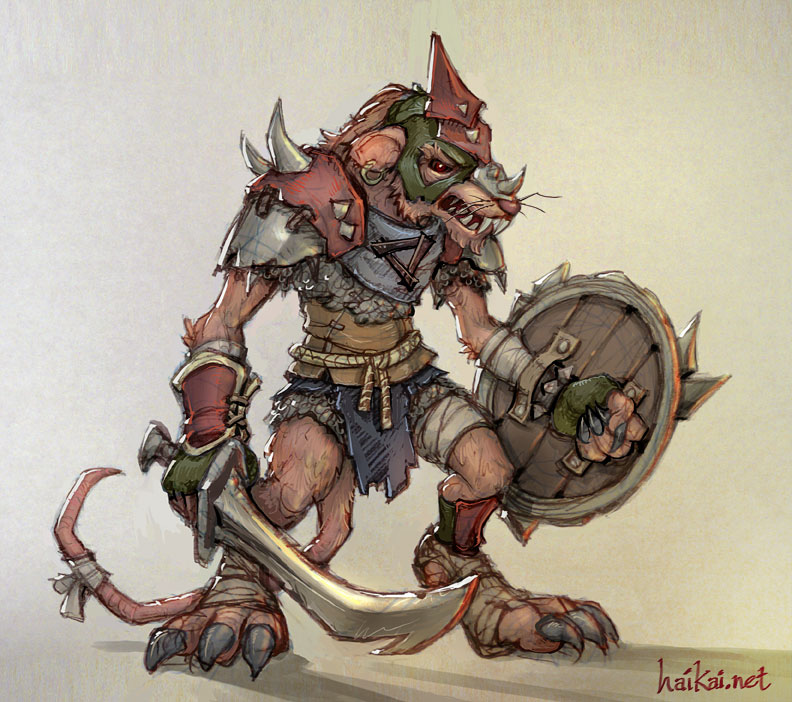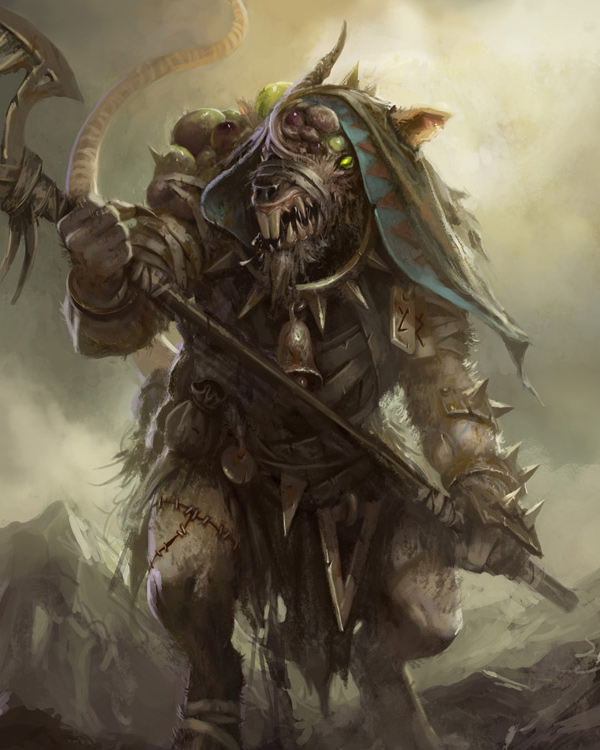I see no reason to re-skin a monster that has already been done. When I say skaven at the table every one already knows what I'm talking about which saves me time.
There are differences between Games Workshop Skaven and the Alerian Skaven.
 |
| Skaven by HaiKai |
First of all I don't know any of the games workshop lore. In fact I'm really not interested in the games workshop lore to be honest. So none of the GW tidbits about skaven really apply here. There is no Horned rat, no massive under city, the number 13 means nothing to Alerian Skaven.
In fact Skaven appear in one location in Aleria, and that's the ruins of Careth. And while they are numerous, and reproduce quickly the dangers of the ruins control their numbers.
The Careth Skavens are a young race, only as old as the ruins.(about 200 years.) They were first reported after the fall of Careth when survivors from the catastrophic battle that raised the city reported seeing them at night. There is speculation that the powerful forces of magic that destroyed the city gave rise to the Skaven. As it is now they stick to the dark corners of the ruins, living underground in a series of excavated warrens.
 Skaven are not learned or mechanical inclined, but they are exceptionally perceptive and devious. They live by scavenging and can make use of just about any found object. Skaven warrens are generaly a miss match of found and stolen objects being used in strange inventive ways.
Skaven are not learned or mechanical inclined, but they are exceptionally perceptive and devious. They live by scavenging and can make use of just about any found object. Skaven warrens are generaly a miss match of found and stolen objects being used in strange inventive ways.Very little escapes their darting eyes or sharp ears. They are crafty hunters preferring to attack when they have advantage and make use of their environment when ever possible.
A lone or outnumbered Skaven will generaly retreat, they are universally fast, nimble, and good at hiding.
The Skaven come in three general types.
 |
| From War hammer online. |
Warriors: These are larger Skaven up to 5 foot tall hunched over, they will wear mixed armor and use what ever mixed weapons they can find. Warrior Skaven act as guards for warrens and also deal with any external treats that present them selves. Warrior Skaven always attack in packs, and generally will retreat rather than fight if they are obviously out-gunned.
Civilian Skaven or run of the mill Skaven. While they are capable of fighting, they often do not carry weapons relying on claws and teeth instead, and will often flee in the face of well armed opposition.
All Skaven share one ability when cornered they can go into a feral fury which allows them three attacks in one around as long as one of those attacks is a bite. So a civilian or scout might get a claw claw, bite, while a warrior might get weapon , weapon, bite.
The Skaven consider the bite a last resort held over from their days as just normal rats. While not particularly damaging the bite will often cause infection and disease in humans which makes the attack something to be feared.
| slapping paint |
Skaven rumors:
These can all be found out by talking to people around the town situated near the ruins of Careth, these are rumors and may or may not be true. The Characters will have enough time to gather up some of these rumors between games.
- Skaven often raise giant rats as pets.
- Skaven are adept at tracking by scent.
- Scout Skaven are difficult to track visually because they are so light on their feat.
- Skavens are very good at hing in shadows and melting into their surroundings.
- Rarely some skavens can speak a broken common and have been known to trade found items for food.
- Skaven armor is usually made up of found objects and is a point of pride to the Skaven wearing it, a subculture of "who can make the most interesting armor" has cropped up among Skaven warriors.
- Rarely a skaven will grow to unusual size (ROUS) these Skaven generaly become leaders or the guards of leaders.
- They worship something under the city but nonone knows exactly what.
- Most Skaven wear simple cloaks, which allow free movement.
- A Skaven stole my baby.
- Skaven can control packs of normal rats.
- Physical mutations are not uncommon among Skaven. (Vern once saw one with two heads!)
- Skaven have a perfected a way of making small smoky bombs out of clay pots.They often use these to cover their escape when retreating from particularly strong enemies.
- They hoard nutts.
- Their leader is a Rat-witch-Were-Rat.
- Skaven have no taste for sour, they simply don't taste it, making just about anything edible to them.
- They have been seen at nigh t in small groups out side of the confines of the ruins, exploring the country side. Nothing good can come of that.
- Skaven realy like sweets, and will trade for candy.
- Skaven fear snakes, and will try to kill them, or run away on sight.

